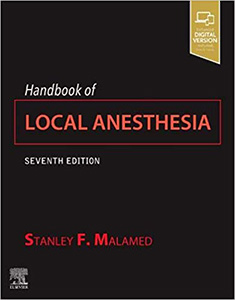Cover image
Title page
Table of Contents
Copyright
Preface
Acknowledgments
Dedication
Contributors
New to This Edition
Part I. Drugs
1. Neurophysiology
Desirable Properties of Local Anesthetics
Fundamentals of Impulse Generation and Transmission
Mode and Site of Action of Local Anesthetics
Active Forms of Local Anesthetics
Kinetics of Local Anesthetic Onset and Duration of Action
2. Pharmacology of Local Anesthetics
Pharmacokinetics of Local Anesthetics
Systemic Actions of Local Anesthetics
3. Pharmacology of Vasoconstrictors
Chemical Structure
Modes of Action
Dilutions of Vasoconstrictors
Pharmacology of Specific Agents
Selection of a Vasoconstrictor
4. Clinical Action of Specific Agents
Selection of a Local Anesthetic
Duration
Maximum Recommended Doses of Local Anesthetics
Ester Local Anesthetics
Amide Local Anesthetics
Anesthetics for Topical Application
Selection of a Local Anesthetic
Part II. The Armamentarium
5. The Syringe
Types of Syringes
Care and Handling of Syringes
Problems
Recommendations
6. The Needle
Types of Needle
Anatomy of a Dental Needle
Care and Handling of Needles
Problems With Needles
Recommendations
7. The Cartridge
Components
Cartridge Contents
Care and Handling
Problems
Recommendations
8. Additional Armamentarium
Topical Antiseptic
Topical Anesthetic
Applicator Sticks
Cotton Gauze
Hemostat
Needle-Recapping Device
9. Preparation of the Armamentarium
Breech-Loading, Metallic or Plastic, Cartridge-Type Syringe
Placing an Additional Cartridge in a (Traditional) Syringe
Self-Aspirating Syringe
Ultra Safety Plus XL Safety Syringe
Part III. Techniques of Regional Anesthesia in Dentistry
10. Physical and Psychological Evaluation
Goals of Physical and Psychological Evaluation
Physical Evaluation
I. Circle Appropriate Answer: (Leave Blank If You Do Not Understand The Question.)
II. Have You Experienced
III. Do You Have Or Have You Had
IV. Do You Have Or Have You Had
V. Are You Taking
VI. Women Only
VII. All Patients
Physical Examination
Additional Evaluation Procedures
Physical Status Classification System
Drug-Drug Interactions and Contraindications
Malignant Hyperthermia
Atypical Plasma Cholinesterase
Methemoglobinemia
11. Basic Injection Technique
◆ Step 1: Use a Sterilized Sharp Needle
◆ Step 2: Check the Flow of Local Anesthetic Solution
◆ Step 3: Determine Whether to Warm the Anesthetic Cartridge or Syringe
◆ Step 4: Position the Patient
◆ Step 5: Dry the Tissue
◆ Step 6: Apply Topical Antiseptic (Optional)
◆ Step 7A: Apply Topical Anesthetic
◆ Step 7B: Communicate With the Patient
◆ Step 8: Establish a Firm Hand Rest
◆ Step 9: Make the Tissue Taut
◆ Step 10: Keep the Syringe Out of the Patient’s Line of Sight
◆ Step 11A: Insert the Needle Into the Mucosa
◆ Step 11B: Watch and Communicate With the Patient
◆ Step 12: Inject Several Drops of Local Anesthetic Solution (Optional)
◆ Step 14: Deposit Several Drops of Local Anesthetic Before Touching the Periosteum
◆ Step 15: Aspirate
◆ Step 16A: Slowly Deposit the Local Anesthetic Solution
◆ Step 16B: Communicate With the Patient
◆ Step 17: Slowly Withdraw the Syringe
◆ Step 18: Observe the Patient
◆ Step 19: Record the Injection in the Patient’s Dental Chart
12. Anatomic Considerations
Trigeminal Nerve
Osteology: Maxilla
Osteology: Mandible
13. Techniques of Maxillary Anesthesia
Local Infiltration
Field Block
Nerve Block
Discussion
Maxillary Injection Techniques
Teeth and Buccal Soft and Hard Tissues
Palatal Anesthesia
Precautions
Summary
14. Techniques of Mandibular Anesthesia
Inferior Alveolar Nerve Block
Buccal Nerve Block
Area Anesthetized
Indication
Mandibular Nerve Block: The Gow-Gates Technique
Vazirani-Akinosi Closed-Mouth Mandibular Block
Indications
Mental Nerve Block
Incisive Nerve Block
Chapter15. Supplemental Injection Techniques
Intraosseous Anesthesia
Intrapulpal Injection
Summary
16. Anesthetic Considerations in Dental Specialties
Endodontics
Pediatric Dentistry
Periodontics
Oral and Maxillofacial Surgery
Fixed Prosthodontics
Long-Duration Local Anesthesia
Dental Hygiene
Part IV. Complications, Legal Considerations, Questions, and the Future
17. Local Complications
Needle Breakage
Prolonged Anesthesia or Paresthesia
Facial Nerve Paralysis
Ocular Complications
Trismus
Soft Tissue Injury
Hematoma
Pain on Injection
Burning on Injection
Infection
Edema
Sloughing of Tissues
Postanesthetic Intraoral Lesions
18. Systemic Complications
Classification of Adverse Drug Reactions
Overdose
Allergy
Consultation and Allergy Testing
Dental Management in the Presence of Alleged Local Anesthetic Allergy
Clinical Manifestations
Time of Onset of Symptoms
Signs and Symptoms
Management
Summary
19. Problems in Achieving Pain Control
Maxillary Teeth
Mandibular Teeth
Pulpally Involved Teeth
20. Recent Advances in Local Anesthesia
Computer-Controlled Local Anesthetic Delivery
Articaine Hydrochloride
Phentolamine Mesylate: The Local Anesthesia “Off” Switch
Buffering (Alkalinizing) of Local Anesthetics: The Local Anesthetic “On” Switch
Tetracaine and Oxymetazoline: Nasal Mist for Anesthesia of Maxillary Nonmolar Teeth
21. Future Trends in Pain Control
Longer- and Ultra-Long-Acting Local Anesthetics
Light-Activated, Light-Inactivated Local Anesthesia
22. Frequently Asked Questions
Local Anesthetics
Vasoconstrictors
Syringes
Needles
Cartridges
Techniques of Regional Anesthesia in Dentistry
23. Legal Considerations
Contract Law
Criminal Law
Tort Law
Health Insurance Portability and Accountability Act of 1996
Legal Considerations Relating to Local Anesthesia Administration
Conclusion
Index


